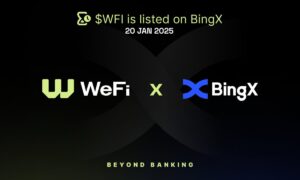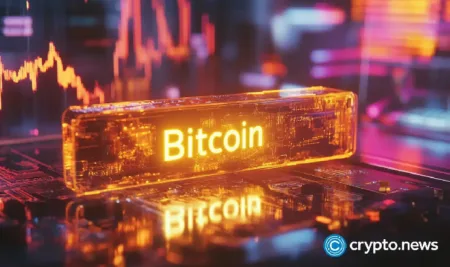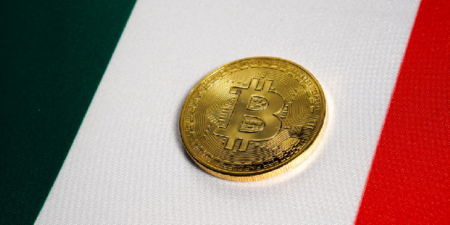At the beginning of March NiceHash, one of the largest and most well-known online markets for hashpower for Bitcoin mining, had decided to give its customers the opportunity to withdraw their earnings from mining activities via the Lightning Network.
Less than a month later, hundreds of new lightning addresses and thousands of transactions processed by the layer-2 network are already being recorded.
All the details below.
NiceHash and the integration of Bitcoin Lighting payment channels for hashpower providers
On March 7th NiceHash, the historic hashpower marketplace of the Bitcoin network, had announced that it had successfully introduced Lightning Network payment channels within its service dedicated to miners.
We are sure you’ve already heard about #NiceHash and its new #Lightning Network Address Functionality. Check our blog to learn what is Lightning Address and how to use it to send and receive your #Bitcoin.https://t.co/0XMMXAuTKR pic.twitter.com/fowemVE92G
— NiceHash (@NiceHashMining) March 19, 2024
This has allowed to make the most of the proceeds from the sale of computing power, as users are no longer required to “cash out” through the main Bitcoin network, paying fees that on average cost $5.72 per transaction according to data from The Block.
Instead, lightning payments are extremely cheap, with fees ranging in the order of magnitude of a few cents, and with very short waiting times.
The integration of this technology has been very well received by NiceHash users who on average have processed about 1,800 weekly payments under the layer-2 of Bitcoin.
In addition, since March 7th, over 700 lightning addresses have been created and 1,136 deposits have also been made, demonstrating the appreciation and interest of the platform’s customers for the added feature.
Overall, since the Nicehash node was added, over 350,000 Lightning transactions have been processed with a transaction volume of over 1,500 BTC.
It is also worth noting how the introduction of the Lightning Network has encouraged small miners to move their earnings more frequently, with an estimated weekly average of almost double the transactions made before the update.
As Vladimir Hozjan, CEO of NiceHash, points out, the decision to add Lightning Network payment options seems to have been well received by their customers. This is what he himself reported in a press release:
“A few weeks after the introduction of Lightning payments, it is clear that our users appreciate this feature. We are proud to be one of the main supporters of the network both in terms of operational nodes, and now in terms of usage. Lightning is very well suited for making small and regular payments, and in the future we will promote its adoption even more.”
The popularity of the NiceHash Hashpower marketplace
Given the success of this experiment, NiceHash has announced that in the future it will enable an option that allows merchants to accept Bitcoin via lightning, aiming to onboard the next billion new small users.
The experience in the sector and advanced knowledge of the technology in question, being Nicehash one of the first supporters of the Lightning Network with over 1250 active channels and a capacity of 180 BTC, make it perfect for exploring the mass adoption of Bitcoin outside the context of mining.
We remind less experienced users that NiceHash represents the hub of online hashpower selling activity, with many small home miners using the service to split the block reward with others similar, rather than opting for the less profitable choice of “solo mining”.
The platform has been active since 2014 and boasts a total Bitcoin network hashrate share of 2.2%, ranking third globally for its performance, thanks to its strong connection with peers.
The service is so famous that it supports over 250,000 active miners every day and more than 1 million total users in 190 different countries.
Currently, according to The Block data, a hashpower share of 1TH/s is priced at 0.11 dollars on the market. In December 2017, at the peak of the Bitcoin bull run, the same amount of computing power cost about 3.50 dollars.
The state of the Layer-2 Lightning Network: active nodes and network capacity
The Lightning Network, the main layer-2 infrastructure of Bitcoin, is expanding more and more becoming popular day by day, but it struggles to emerge as a widespread technology for the masses.
Despite the great efforts of the community that have allowed the chain to grow rapidly from 2019 to 2023, we now seem to have entered a phase of stagnation.
In particular, as reported by The Block, since May 2023 the network capacity calculated in BTC has significantly decreased, going from 5,640 BTC to the current 4,730 BTC.
The appreciation of the currency has led to the dollar value of the network’s capacity growing overall in recent months, bringing this metric to a historical high of approximately 350 million dollars at the beginning of 2024.
The net number of P2P channels opened has been sharply declining since March 2022, with a decreasing trend that has led to a reduction of about 30,000 connections.
If this trend does not reverse and the price of BTC were to encounter a bear market, the possibility of hosting expensive transactions on the network will drastically decrease.
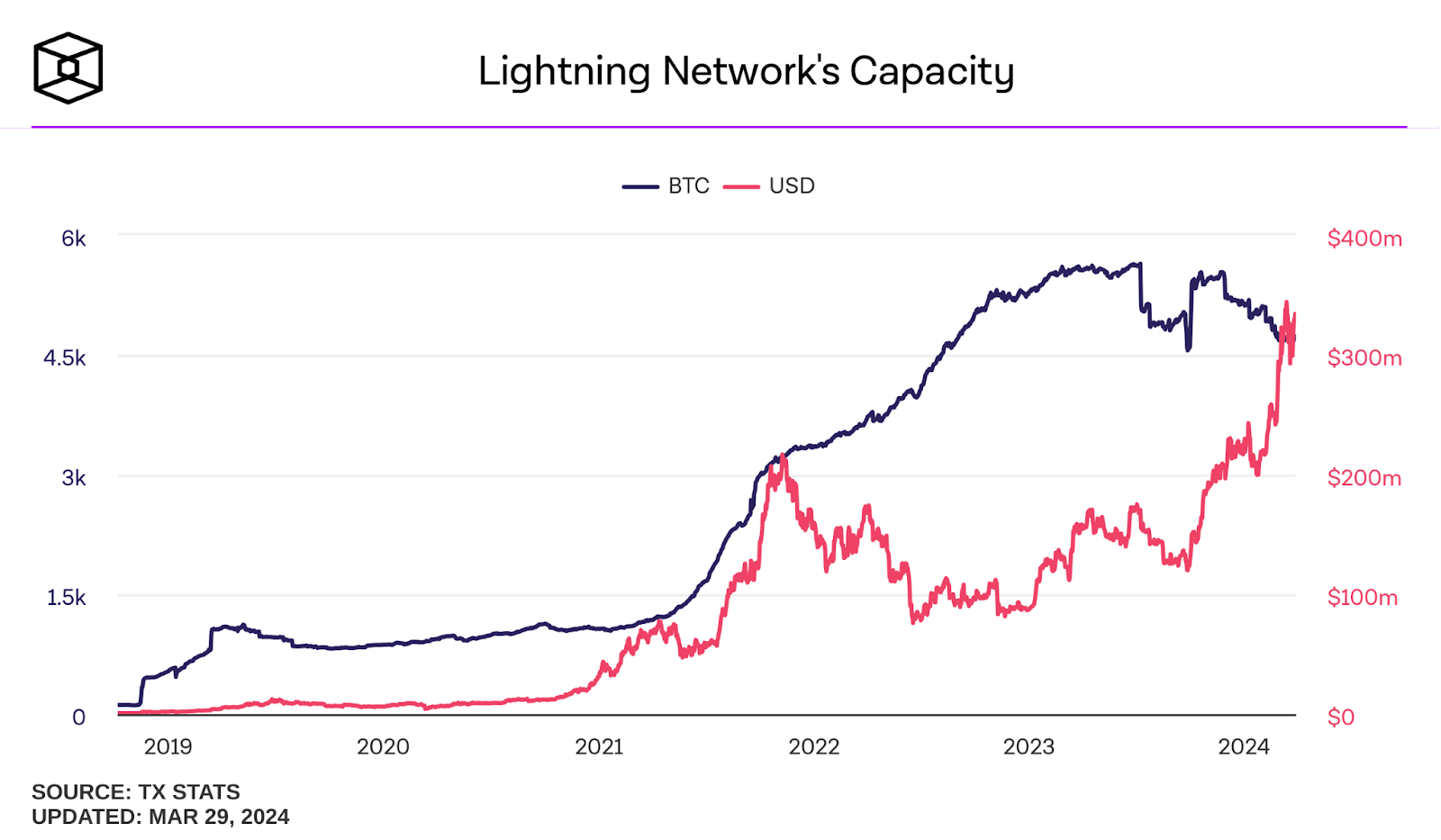
Furthermore, it is interesting to report the overall outlook of lightning node managers, who see a strong concentration around two individual providers, Amazon and Google Cloud.
The two tech giants respectively hold stakes of 530 and 79 nodes, with 1,700 and 947 BTC under management.
Together, according to Mempool Space data, they make up about 45% of the lightning node provider landscape, thus centralizing a system that was originally conceived with the idea of decentralization.
It is also worth mentioning that out of the total 13,000 active nodes in the chain, about 70% are exclusively dedicated to the Darknet (Tor, I2P, cjdns) with an estimated capacity of just 190 BTC, while the remaining 30% (spread between Clearnet and unknown sources) manages the majority of the capacity equal to 4000 BTC.
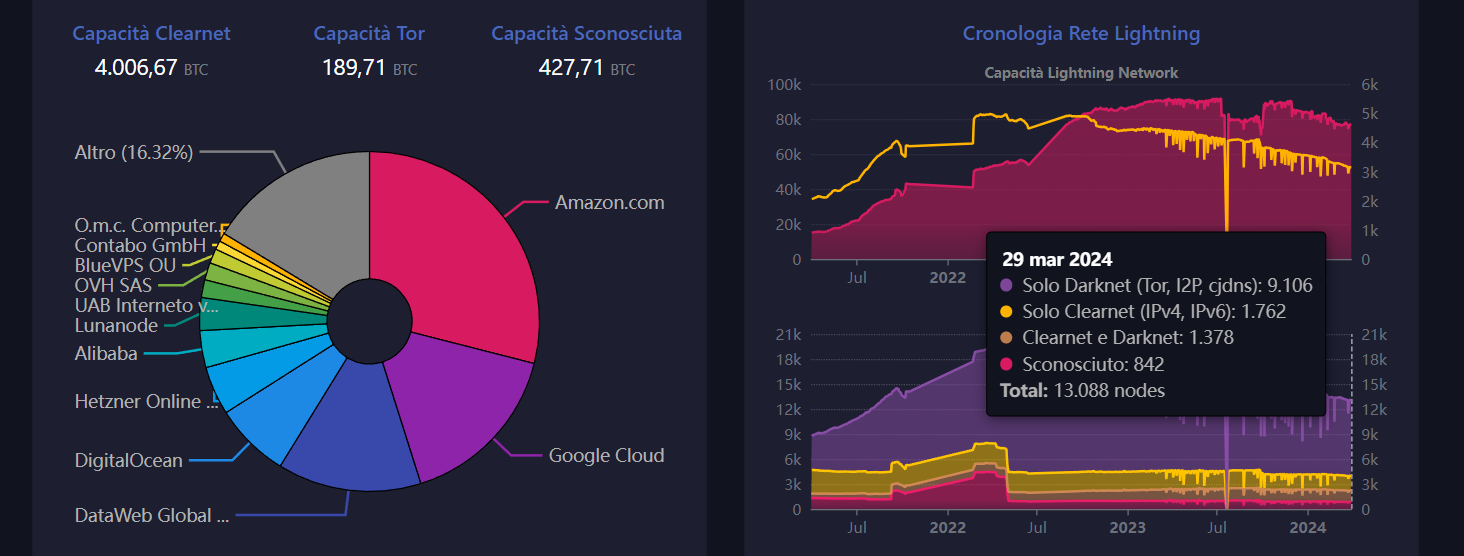
Read the full article here

